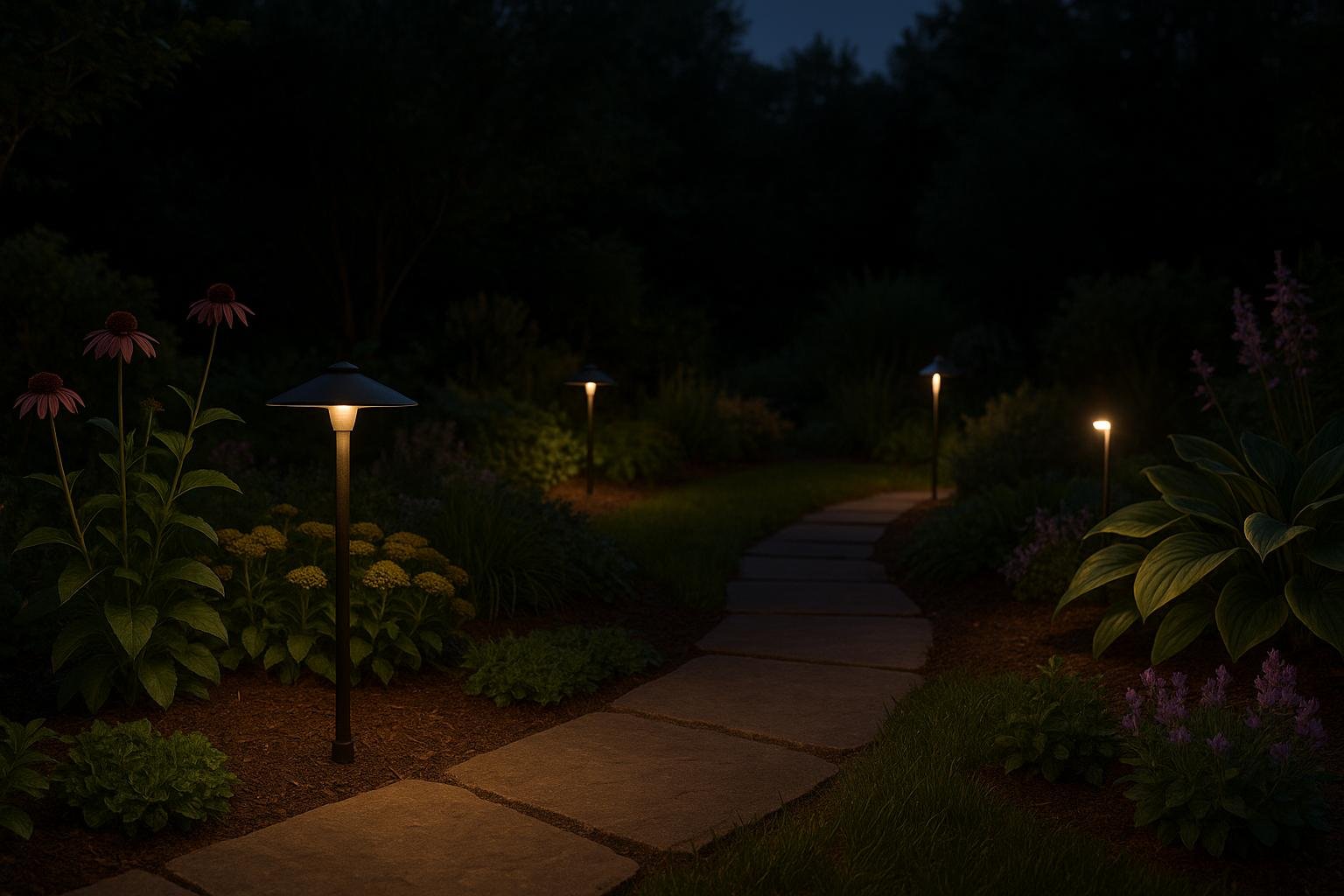7 Common Low Voltage Lighting Problems

Low voltage lighting systems are energy-efficient and enhance outdoor spaces beautifully. However, they often face issues like voltage drops, transformer malfunctions, and flickering LEDs. Here’s a quick look at common problems and their fixes:
- Voltage Drops: Use thicker cables, multi-tap transformers, or the hub method to maintain consistent brightness.
- Transformer Issues: Avoid overloading and regularly inspect for overheating or loose connections.
- Wire Connection Problems: Secure and waterproof connections to prevent flickering or outages.
- LED Flicker: Check for compatible dimmers, stable voltage, and clean connections.
- Corrosion: Clean or replace corroded parts and use weatherproof materials.
- Timer/Photocell Errors: Reset timers, clean sensors, and ensure proper placement to avoid schedule disruptions.
- Broken Fixtures: Replace damaged parts with durable materials like brass or stainless steel.
Quick Tip: Regular maintenance - like cleaning, inspecting, and using high-quality components - can extend the lifespan of your system by years.
Troubleshoot Outdoor Landscape Lights Not Working

1. Long Cable Voltage Drop
Voltage drop can be a real headache in low-voltage lighting systems. It happens when the resistance in the wiring causes a loss of voltage over long cable runs. This often leads to dim or flickering lights, especially in fixtures farthest from the transformer. While the standard voltage in U.S. households is 120 volts, outdoor lighting systems usually run at just 12 volts - which makes them much more prone to voltage drop issues.
"Voltage drop is defined as the amount of voltage loss that occurs through all or part of a circuit due to impedance".
Factors like the length and gauge of the cable, the number of fixtures on the circuit, and the total wattage load all play a role in how severe the voltage drop will be.
"Despite what the manufacturers say, if you want to get the most out of your outdoor lighting system, you need to make sure that each fixture is getting as close to 12 volts of electricity as possible".
Here are some ways to keep your lights running at the right voltage:
- Hub Method Installation: Connect each fixture directly to a central hub to ensure an even voltage distribution.
- Choose the Right Wire Gauge: Use a wire gauge that matches the wattage and length of your cable run.
-
Use a Multi-Tap Transformer:
"To control voltage drop in low-voltage landscape lighting systems, there are two things to consider. The first is having a multi-tap transformer to compensate for voltage drop by having several higher-voltage taps available".
For the best results, aim to maintain a steady voltage of 13 to 13.5 volts at each fixture. Keep in mind that white LED lights often need a little extra power to shine at their brightest.
To keep your system running smoothly over time, consider these additional tips:
- Place the transformer in a central location to reduce the length of cable runs.
- Avoid daisy-chaining fixtures, as this can lead to uneven voltage distribution.
- Protect underground wiring with conduit to prevent damage.
- For longer runs, use a loop design to balance the voltage more effectively.
2. Transformer Problems
Problems with your transformer can disrupt your garden's low-voltage lighting system. When a transformer isn't working properly, it often gives off noticeable warning signs.
Here are some common issues to watch out for:
- Overheating: If the transformer feels unusually hot or makes buzzing, humming, or clicking noises, it's likely struggling to handle the load.
- Inconsistent Power: Flickering lights, unexpected dimming, or lights that refuse to turn on could point to an overloaded transformer or connection problems.
- Connection Issues: Loose or corroded connections can lead to voltage fluctuations and even complete system failure.
Troubleshooting Transformer Problems
To pinpoint what's wrong with your transformer, follow these steps:
-
Check the Power Source
Make sure the transformer is receiving power. If it's connected to a GFCI outlet that doesn't reset automatically, check your breaker panel for any tripped circuits. -
Assess the Load
Ensure the transformer isn't overloaded. As a rule of thumb, operate it at no more than 80% of its rated capacity. For instance, if you have a 300-watt transformer, it should power no more than 240 watts of lighting. -
Perform Regular Maintenance
Annual maintenance can prevent many common issues. Include these tasks in your routine:- Clear out debris and insects from the transformer housing.
- Tighten all electrical connections.
- Inspect the weatherproof cover for any damage.
- Test the GFCI receptacle to ensure it's functioning properly.
Quick Reference for Common Problems
| Problem | Likely Cause | Solution |
|---|---|---|
| No Power | Tripped GFCI or breaker | Reset the GFCI or check the breaker panel. |
| Overheating | Exceeding capacity | Reduce the load or upgrade the transformer. |
| Flickering Lights | Loose connections | Tighten all connections and check grounding. |
| Dim Lights | Voltage drop | Use the correct wire gauge and balance the load. |
Tips for Long-Term Performance
For reliable operation, install the transformer in a well-ventilated area and ensure it's protected from the elements. If you spot any significant wear or damage, it's best to contact a professional - handling electrical repairs yourself can be risky.
Additionally, using surge protectors and ensuring proper grounding can help prevent power inconsistencies. These measures not only improve the reliability of your lighting system but also extend its lifespan and enhance energy efficiency.
🚀 Ready to Reinvent Your Garden?
Join thousands of homeowners who have transformed their gardens using our AI design tool. Upload one photo to explore endless possibilities.
Get your AI garden designs →3. Wire Connection Issues
Ensuring proper wire connections is just as crucial as maintaining a steady voltage supply when it comes to keeping a low voltage system running smoothly. Much like transformer issues, faulty connections can disrupt performance and demand immediate attention.
Common Signs of Connection Problems
Here are some red flags that might indicate connection issues:
- Lights flickering, dimming, or experiencing partial outages
- Heat buildup at connection points or discoloration around them
- Visible damage, such as burnt insulation, corroded terminals, or loose wire nuts
Professional Solutions
VOLT® Lighting offers a proven approach to resolving wire connection problems using DryConn® Black and Grey Waterproof Connectors. Here’s how you can tackle the issue:
- Power Down: Turn off the transformer and unplug it from its power source.
- Inspect Thoroughly: Examine all wire connections for signs of damage.
- Strip the Insulation: Remove about ½ inch of insulation from the ends of the wires.
- Twist Together: Tightly twist the exposed copper ends of the wires.
- Seal the Connection: Place the wires into silicone-filled waterproof connectors to protect them.
Preventive Maintenance
To avoid future connection issues, incorporate these practices into your routine:
- Regularly inspect connections for signs of wear or corrosion.
- Use cable management tools to minimize stress on the wires.
- Protect connections from moisture by applying silicone sealant.
- Label connections for easier troubleshooting down the line.
"Cable connection points are often the point of failure of outdoor lighting systems, so it is critical to ensure the connection is secure the first time." – VOLT® Lighting
Professional Tip
Before working on any wires, always double-check that the voltage is deactivated to ensure your safety.
4. LED Light Flicker
LED light flicker can ruin the visual appeal of outdoor spaces, but understanding its causes and how to fix it can help ensure your lighting works as intended.
Common Causes of LED Flicker
Several factors can lead to LED lights flickering:
- Small voltage fluctuations caused by an unstable power supply
- Damaged or improperly installed wiring
- Dimmer switches that aren’t compatible with LED lights
- Insufficient power distribution across the system
- Weather-related damage or debris interfering with connections
These issues don’t just disrupt the light’s output - they can also hurt the overall quality of your lighting setup.
Impact on Lighting Quality
"Lighting quality goes beyond brightness and color temperature - flicker is a critical factor affecting comfort, productivity, and even safety".
Flickering lights can lead to discomfort, reduce visibility, and, in some cases, create safety hazards.
Professional Solutions
If you’re dealing with flickering lights, start by inspecting the basics before diving into more complex fixes. Here’s how:
-
Initial System Check
- Make sure all bulbs and wiring connections are secure.
- Test voltage levels at key points like fixtures, junctions, and transformers.
-
Power Supply Assessment
- Confirm that your transformer can handle the total wattage of your LED setup.
- Upgrade to an ELV (Electronic Low Voltage) or MLV (Magnetic Low Voltage) power supply if necessary.
-
Dimmer Evaluation
"Using old dimmers designed for halogen lights on LED downlights will most likely cause flickering".
- If your dimmer isn’t LED-compatible, replace it with one designed specifically for LED lights.
Preventive Maintenance
To keep flickering at bay, consider these steps:
- Regularly clean sockets and connectors to remove debris.
- Monitor voltage levels to ensure stability.
- Protect connections from weather exposure.
- Distribute the electrical load evenly across your system.
- Schedule routine inspections to catch potential issues early.
When troubleshooting, start with the simplest fixes - like cleaning and securing connections - before moving on to more technical solutions.
Professional Tip
Always begin by checking the connections and cleaning contact points. These simple steps often resolve flicker issues without the need for more advanced troubleshooting.
sbb-itb-4d6a8dd
5. Contact Point Corrosion
Contact point corrosion is a common issue that, much like wiring and transformer problems, can disrupt low voltage lighting systems. Addressing this problem is key to maintaining consistent performance and avoiding larger complications.
Understanding Corrosion Impact
"Corrosion occurs when the surface of the wire is exposed to oxygen and moisture, which causes the metal to degrade over time." - Low Voltage Nation
Corrosion can negatively impact your lighting system in several ways, including:
- Reduced conductivity
- Increased energy consumption
- Elevated fire hazards
- Shortened lifespan of fixtures
Identifying Corrosion Signs
Keep an eye out for these telltale signs of corrosion:
- Wire connections that appear discolored or have a greenish tint
- Visible rust or oxidation on components
- Lights that flicker or dim unexpectedly
- Connection points that feel unusually warm
- Overall decline in electrical performance
Professional Solutions
-
Cleaning Corroded Contacts
Start by disconnecting the power. Then, gently sand corroded areas using fine sandpaper or steel wool. Clean the surface with acetone or alcohol to remove grease and debris, ensuring no residue is left behind. -
Handling Severe Corrosion
If the corrosion is extensive, replacing the affected components is the safest and most effective solution.
Prevention Measures
To minimize the risk of corrosion, consider these proactive steps:
- Use waterproof direct burial splices.
- Seal fixture openings with silicone.
- Opt for weatherproof electrical connectors.
- Choose materials that resist corrosion.
- Keep wiring organized and secure.
- Perform regular system inspections.
Material Selection Guide
When selecting materials for your lighting system, keep corrosion resistance and use cases in mind:
| Material | Corrosion Resistance | Best Use Case |
|---|---|---|
| Solid Brass | Long-lasting durability | Ideal for outdoor fixtures |
| Stainless Steel | Excellent stability | Great for exposed connections |
| Aluminum | Moderate resistance | Budget-conscious options |
| Plastic | Limited durability | Temporary or low-cost solutions |
Maintenance Tips
To ensure your system stays in top shape:
- Regularly inspect wires for early signs of corrosion.
- Keep all connections dry and properly sealed.
- Apply corrosion inhibitors in areas prone to moisture.
- Replace any damaged parts as soon as possible.
In the next section, we’ll explore timer and photocell errors, which can also disrupt the efficiency of your lighting system.
6. Timer and Photocell Errors
Issues with timers and photocells can throw your garden lighting system off schedule, disrupting its intended operation. Getting a handle on these problems is key to keeping your low-voltage lighting running smoothly.
Common Timer Issues
Timers usually fail in one of two ways:
- Incorrect on/off scheduling
- Complete failure to operate
These problems often result from loose connections or programming errors, particularly after a power outage.
Photocell Complications
Photocells, which help automate lighting based on daylight, can run into several challenges. Here’s a breakdown:
| Issue | Cause | Solution |
|---|---|---|
| Lights stay on all day | Blocked sensor or faulty wiring | Clean the sensor and check the wiring |
| No night activation | Interference from artificial light | Reposition the sensor to avoid interference |
| Delayed response | Voltage mismatch | Ensure the sensor voltage matches the system |
| Intermittent operation | Moisture infiltration | Seal connections and protect the housing |
Addressing these issues requires a methodical approach to troubleshooting.
Troubleshooting Steps
-
Timer Diagnostics
Start by resetting the transformer and reprogramming the timer. If the issue persists, inspect the power supply for interruptions. -
Photocell Testing
Cover the photocell to simulate nighttime conditions. If the lights don’t activate, look for dirt, physical obstructions, wiring problems, or mismatched voltage. -
Environmental Factors
Environmental elements can impact photocell performance. Check for overgrown vegetation, nearby artificial light sources, or anything else that might interfere. Adjust the sensor's position as needed.
Preventive Maintenance
Regular upkeep can help you avoid most timer and photocell issues. Here are some tips:
- Wipe down photocell surfaces every month to remove dirt and debris.
- Recheck timer settings after power outages.
- Inspect all electrical connections quarterly for wear or looseness.
- Replace battery backups annually to ensure uninterrupted operation.
- Trim plants or other obstructions near sensors to keep them clear.
Smart System Considerations
If your system includes smart controls, take these additional steps:
- Resync Bluetooth connections after power interruptions.
- Update your control software whenever a new version is available.
- Confirm network connectivity for any Wi-Fi-enabled devices.
- Check data line connections for stability.
Professional Solutions
When DIY troubleshooting doesn’t work, it might be time to explore professional upgrades:
- Switch to an astronomical timer for more precise scheduling.
- Replace outdated photocells with newer, more reliable models.
- Upgrade to a digital control system for enhanced functionality.
- Add surge protection to shield your system from power spikes.
These upgrades can improve reliability and ensure your garden lighting system operates without a hitch.
🎨 Visualize Your Dream Garden Today!
Transform any outdoor space into a professional landscape design in minutes. Just upload a photo, choose your style, and let our AI do the rest.
Start your garden transformation now →7. Broken Light Fixtures
Physical damage to light fixtures can severely affect the reliability of a lighting system, going beyond just electrical or control issues. When fixtures are damaged, both performance and safety are compromised. Spotting damage early and applying the right fixes ensures lighting stays consistent and dependable.
Types of Physical Damage
Different parts of a fixture are prone to specific types of damage:
| Component | Common Damage | Primary Causes |
|---|---|---|
| Ground Stakes | Cracking or snapping | Lawn equipment or frost heave |
| Glass Lenses | Shattering, scratches | Landscaping mishaps or flying debris |
| Housing/Neck | Corrosion, breaks | Weather exposure or physical impacts |
| Seals/Gaskets | Deterioration | UV rays or extreme temperature shifts |
How Damage Affects Performance
Broken fixtures can lead to a range of problems, including:
- Water getting inside, causing electrical shorts
- Uneven lighting that disrupts the overall look
- Higher energy use due to inefficiencies
- Safety risks from exposed or malfunctioning parts
- Shortened lifespan of the entire system
Professional-Grade Fixes
When replacing damaged fixtures, consider the following:
-
Material Selection
Opt for durable materials like copper or brass. These metals develop a protective patina over time, making them resistant to wear and tear. -
Matching Specifications
Replacement fixtures should align with the original system's:- Color temperature (Kelvin)
- Brightness (lumen output)
- Light spread (beam angle)
- Voltage requirements
-
Improved Installation
To make fixtures more durable:- Use brass ground stakes for added strength
- Install protective shields in high-traffic zones
- Position fixtures away from areas prone to damage
- Ensure proper drainage around the base to prevent water pooling
Preventive Measures
Protecting fixtures from damage is easier with regular care. Some tips include:
- Inspecting fixtures monthly for signs of wear
- Cleaning them routinely to remove dirt and debris
- Trimming nearby plants to avoid interference
- Using protected wiring to reduce exposure
- Installing fixtures under eaves or other sheltered areas when possible
Repair or Replace?
Deciding whether to repair or replace hinges on the type of damage. Here’s a quick guide:
| Damage Type | Action Required | Reason |
|---|---|---|
| Cracked Housing | Replace | Waterproofing is compromised |
| Failed LED Driver | Replace | Component is not repairable |
| Broken Ground Stake | Replace stake only | Fixture itself remains usable |
| Water Infiltration | Replace seals/gaskets | Prevents further electrical issues |
"A broken fixture is a broken fixture. It will need to be replaced." - Landscape Lighting Pro
For modern LED fixtures, which last between 15,000 and 50,000 hours, replacement is often the best option. Upgrading to newer LED designs not only improves durability but also enhances energy efficiency.
Problem and Solution Chart
Below is a handy chart that outlines common issues, their causes, potential fixes, and the associated costs. Whether you're tackling these problems on your own or calling in a pro, this guide can help you plan ahead:
| Problem | Common Causes | DIY Solution | Professional Solution | Average Cost |
|---|---|---|---|---|
| Voltage Drop | Long cable runs, inadequate wire gauge | Install thicker cables, add transformer | Cable upgrade, transformer replacement | $150–$465 |
| Transformer Issues | Overloading, surge damage, loose connections | Check connections, reset breaker | Replace the transformer | $260–$500 |
| Wire Connections | Corrosion, water damage, loose fittings | Clean contacts, tighten connections | Rewiring sections | $175–$325 |
| LED Flicker | Incompatible bulbs, connection issues | Replace bulbs, check connections | System diagnostic and repair | $120–$260 |
| Contact Corrosion | Moisture exposure, age | Clean with a wire brush | Replace fixture components | $135–$250 |
| Timer/Photocell | Programming errors, sensor failure | Reset timer, clean photocell | Replace control unit | $150–$300 |
| Broken Fixtures | Physical damage, weather exposure | Replace fixture | Professional installation | $509–$647 |
Cost-Saving Tips
Electricians typically charge between $50 and $120 per hour. To keep repair costs manageable, consider these strategies:
- Combine several repairs into one service call to save on labor fees.
- Handle straightforward maintenance tasks, like cleaning or resetting, yourself.
- Address small issues promptly to prevent them from escalating into bigger (and pricier) problems.
- Invest in durable, high-quality replacement parts to reduce the frequency of repairs.
Technical Specifications Guide
When troubleshooting or replacing components, it's essential to follow the correct technical requirements. Here's a quick reference to guide you:
| Component | Requirements | Important Notes |
|---|---|---|
| Transformer | 120V input, 12V output | Operate at no more than 80% capacity |
| Wire Gauge | Based on run length | Use thicker wires for longer distances |
| LED Bulbs | Match system voltage | Ensure compatibility with the system |
| Connections | Waterproof rated | Use materials designed for outdoor use |
For accurate troubleshooting, use a multimeter to measure voltage at key points in the system. Also, make sure all connections are properly sealed to prevent moisture-related damage. Following these guidelines will help you ensure that any replacement parts or upgrades align with your system's requirements.
Summary
Proper maintenance of your low voltage lighting system can significantly extend its lifespan - potentially up to 20–30 years.
Key Maintenance Tips
- Perform inspections every three months, increasing to monthly during severe weather.
- Use a soft cloth to clean fixtures regularly and maintain their brightness.
- Check all wire connections for any signs of damage or wear.
- Test fixture voltage levels with a voltmeter to ensure proper operation.
- Replace damaged components with outdoor-rated parts designed for durability.
"Maintaining outdoor lighting is crucial for security and safety. Well-lit properties deter intruders, making it essential for businesses and residential areas. Consistent maintenance also reduces the risks of accidents like trips and falls or, in the worst case, an electrical fire." - CAST Lighting
To further enhance the lifespan and performance of your system, consider adopting these best practices:
Best Practices for Longevity
- Install surge protectors to safeguard against power fluctuations.
- Opt for marine-grade, tin-coated wire for better resistance to harsh weather.
- Choose fixtures made of bronze or solid brass for added durability.
- Follow the 100/100 rule: limit cable runs to 100 feet of 12-gauge wire per 100 watts of lighting.
- Use waterproof connectors to protect against moisture damage.
Detecting and addressing issues early can save you from costly repairs down the line. Schedule a thorough system inspection at least once a year. By staying proactive and using high-quality, outdoor-rated components that align with your system's specifications, you’ll ensure your lighting remains reliable and visually appealing for years to come.
FAQs
How can I avoid voltage drops in my low voltage lighting system for consistent brightness?
To maintain consistent brightness and avoid voltage drops in your low voltage lighting system, start by opting for thicker wires (lower gauge numbers). Thicker wires reduce resistance, allowing power to flow more efficiently. Additionally, aim to keep wire runs as short as possible and avoid daisy chaining too many fixtures. Instead, distribute power more evenly by splitting the runs.
For larger setups, you might need to add power injection at multiple points along the circuit. This helps stabilize voltage levels, ensuring every fixture gets the power it needs to keep your garden lighting bright and evenly illuminated.
How can I tell if my low voltage lighting transformer is malfunctioning, and what steps can I take to fix it?
If your low-voltage lighting transformer isn't working properly, you might experience a few telltale signs: lights not turning on at all, flickering or dim illumination, overheating, or even strange buzzing or clicking noises. Another red flag is inconsistent voltage output, which can lead to uneven lighting across your setup.
To get to the root of the problem, start by checking if the transformer is actually getting power from the outlet. Look for any visible issues like damaged wiring, loose connections, or signs of overheating. Grab a multimeter to measure the voltage output and make sure it falls within the required range. If you discover the transformer is overloaded, you can either spread the load more evenly across circuits or upgrade to a transformer with a higher capacity. Tackling these problems early can save you from bigger headaches and help your garden lighting shine reliably.
How can I prevent and fix corrosion in my low voltage garden lighting system to keep it working efficiently?
To keep your low voltage garden lighting system in top shape and free from corrosion, start with the right materials. Opt for durable, corrosion-resistant options like solid brass or copper for your fixtures. These materials stand up to the elements far better than aluminum, which is more prone to rust. Pair them with waterproof connectors and splices designed for direct burial to shield your system from moisture.
Ongoing maintenance is just as important. Regularly inspect your lighting system, focusing on connections and fixtures, for any signs of corrosion. If you spot any trouble areas, clean them thoroughly and apply dielectric grease to protect the connections from moisture. For severe corrosion, it’s best to replace the damaged parts to keep your system running smoothly.
With these precautions, you’ll not only protect your investment but also enjoy a beautifully illuminated garden for years to come.
🌺 Professional Garden Design in Minutes!
Stop wondering what your garden could look like. Upload a photo and let our AI show you 50+ professional design possibilities instantly.
Transform your garden now →Related posts
Related Articles

Top 7 AI Garden Styles for Any Space
Explore seven distinct AI-driven garden styles, from modern minimalism to lush edible landscapes, tailored to fit any space and climate.

Ultimate Guide to Meditation Garden Boundaries
Explore how to create serene meditation garden boundaries with living and built elements for privacy, tranquility, and natural beauty.

AI Tools for Managing Sun and Shade in Gardens
Explore how AI tools enhance garden management by optimizing sunlight and shade for healthier plants and better yields.

The Ultimate Guide to Raised Garden Planters on Legs
Learn about the benefits of using raised garden planters on legs, factors to consider when choosing one, and how to build your own. Perfect for those with limited space!

AI Tools for Creating Low-Maintenance Plant Combinations
Explore AI tools that simplify garden planning by matching plants to your conditions, ensuring low-maintenance and visually appealing combinations.

Modern vs. Classic Garden Themes: AI Design Tips
Explore the differences between modern and classic garden styles with AI design tools that simplify planning and plant selection.